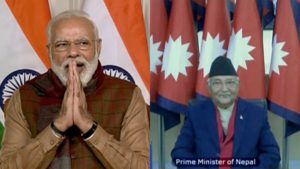India’s Defence Minister Rajnath Singh inaugurated strategically important and an extremely crucial road of 80 km from Tawaghat to Lipulekh in Pithoragarh district in Uttarakhand on 7 May 2020 via video-conferencing. It passes through an extremely difficult terrain reducing the travel time from three weeks to one week to visit Kailash Mansarovar.
Earlier road existed till Tawaghat which is approximately 15 km ahead of Dharchula and thereafter only foot or mule track was available upto Lipulekh, running parallel to west of Kalinadi. From Lipulekh onwards there was by and large a proper road track on China’s side till Kailash Mansarovar. The new road now constructed from Tawaghat till Lipulekh has followed the same alignment of the earlier existing track and was to be completed in five years by 2013 by the Border Road Organisation.

But due to hazardous terrain and road passing through altitude ranging from 6,000 to 17,000 ft, the construction progress on the construction was extremely slow. However, from 2019 onwards IAF’s newly acquired Chinook helicopters were brought in the action to ferry heavy equipment and machinery which proved to be the game changer and hastened up the speed of the road construction.
This road is not only important to India for movement of pilgrims to Kailash Mansarover, tourism and trade but has significant strategic importance for logistic build up and fast induction of troops against China. The Nepal government has raised objections on this project claiming that road is passing through their territory and action of the Indian government is unilateral, possibly on egging by China and also to satisfy hyper nationalist ego of domestic population and of ruling communist party.
A resolution has recently been passed by the Nepal government in the cabinet that Kalapani, Lipulekh and Limpiyadhura are all part of Nepal and should be taken back at all cost, including through diplomatic and political means. Accordingly, political map to this effect has also been released by them. Nepal also claims that India clandestinely has shown these areas in their political map released late last year. Whereas the Indian government is firm that ibid road is within Indian territory and followed same alignment of the earlier existing track used by the pilgrims visiting Kailash Mansarovar.
India feels that Nepal has never in the past raised any objection on this road/track being used by the pilgrims visiting Kailash Mansarovar. Nor it raised any issue when the road was being constructed for last more than 10 years. India strongly feels that this is being done due to pressure exerted by the Chinese government and also to keep the fragile unity in ruling communist party intact.
Political map which was released last year by India was necessitated due to bifurcation of Jammu & Kashmir state in two Union Territories after abrogation of Article 370 and 35A. And it did not alter in any way the boundary with Nepal. India pointed out that Nepal’s artificial enlargement of its claims are not backed by historical facts and advised Nepal to respect the territorial sovereignty of India.
In recent past, India and Nepal have resolved most of the border disputes except Kalinadi and Lipulekh area in frank and friendlier manner. Both the countries claim that Kalinadi, Lipulekh and Limpiyadhura fall in their respective territories. Nepal advocates that the abovementioned area falls in their Dharchula district and claims to have historical evidence of 1816 treaty of Sugauli with British India in this regard whereas India feels that Lipulekh is tri-junction point between India, China and Nepal and the road runs west of Kalinadi which falls into Pithoragarh district of India.
Nepal is one of the most important neighbours of India in South Asia with historical, cultural, religious and social ties. This also becomes a sensitive issue since there are about 15,000 Gorkha soldiers serving in various regiments of Indian Army any point of time. There is well established protocol and mechanism existing between both the friendly countries to resolve such boundary issues diplomatically and politically.
Therefore, relations between both the friendly countries should not be allowed to go down the hill. Instead we should have meeting at the foreign secretary level to resolve the issue amicably at the earliest, taking all the aspects into consideration, in the spirit of mutual respect and friendship. Till the time, border dispute is not resolved amicably between India and Nepal the relations are going to remain strained. Nepal is raising the border issue at China’s behest.
At the same time, China is investing in Nepal in a major way to make Nepal more dependent on it. Nepal falling in China’s debt trap cannot be ruled out. India will have to deal with Nepal tactfully and even exert pressure. Nepal being a land-locked country is dependent on India mainly for oil and communication in addition to trade moving through India.
Keeping the bondage of friendship existing between both the nations in mind, let’s hope the matter is resolved on priority to the satisfaction of both of them. Maj Gen Ashwani Siwach (retd) retired from Indian Army as Director General, territorial Army, in 2014 after serving for almost 37 years. He has a long experience of serving in counter-terrorism and counter-insurgency environment in J&K and Northeast. He commanded the brigade on the Line of Control in Kashmir. He was also the Chief of staff of Corps in Ladakh deployed against China and Pakistan.














